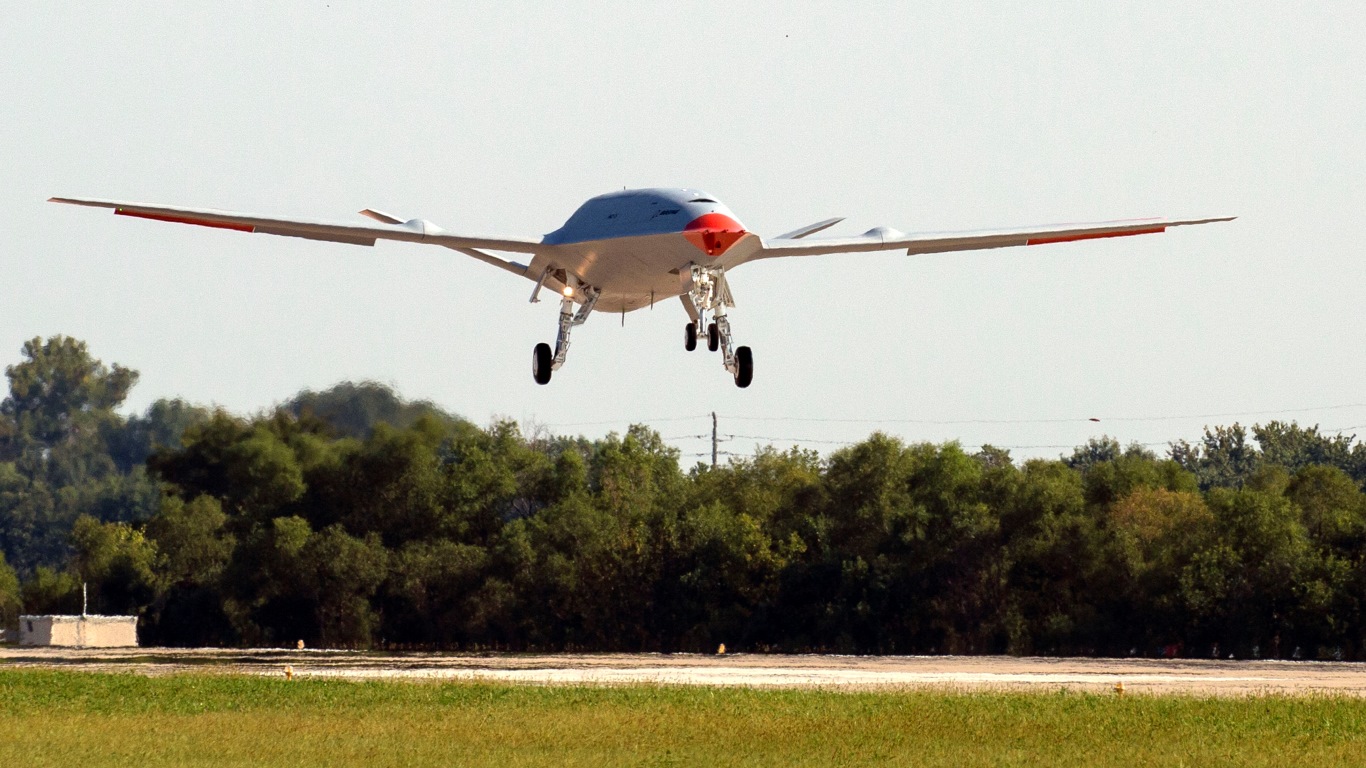Military
Boeing Flies Navy Drone Tanker for First Time, Struggles With Air Force Tanker

Published:
Last Updated:

With so much focus on Boeing Co.’s (NYSE: BA) problems with its 737 Max commercial passenger jet, it’s not difficult to overlook the company’s defense business. Boeing has two high-profile defense contracts currently in the works, the first, awarded in 2011 to provide the U.S. Air Force with 179 KC-46 refueling tankers and the second, awarded last September, to supply the first four unmanned tankers to the U.S. Navy.
On Thursday, Boeing successfully completed the first flight of its drone tanker, the MQ-25 Stingray. The two-hour test flight was controlled by Boeing test pilots situated in a ground control station at the company’s test facility in suburban St. Louis.
The drone tanker is being designed to transport 14,000 pounds of fuel to the Navy’s carrier-based fighter jets. That’s about 2,000 gallons. The carrier version of a Lockheed Martin Inc. (NYSE: LMT), the F-35C, is capable of carrying more than 18,000 pounds of fuel when fully loaded. That’s enough to fly 1,200 nautical miles (nm), but not enough to allow Navy carriers to remain outside the range of new Chinese ground-based missiles that reportedly have a range of 1,500 nm. The drone’s purpose is to extend the range of carrier-based jets so that the $13 billion carriers can remain beyond the reach of ground-based missile defenses.
The Navy’s contract with Boeing calls for the MQ-25 to be capable of delivering fuel 500 nm from the carrier. The company is on the hook to deliver four of engineering development models of the drone under a contract price of $805 million. If the Navy accepts delivery and extends the contract, Boeing will deliver up to 72 drones at a total cost to the Navy of $13 billion, roughly equal to the cost of just one carrier.
While Boeing’s drone test was a success, similar success is more difficult to come by in its $49 billion contract to deliver 179 KC-46 tankers to the Air Force. On Wednesday, General Maryanne Miller, head of the Air Force’s Air Mobility Command, said there were nine “critical performance parameters” dogging the new tanker’s refueling systems. She also noted that Boeing and the Air Force are “making progress” to fix seven, but “two are very difficult.”
One of the hard problems is a video system that is supposed to help the refueling operator guide the boom into the aircraft that will be receiving fuel. According to a report at Defense One, a former Air Force official who worked on the tanker program said that Boeing insisted on developing the camera system in-house even though “there were many, many companies out there that could have done it better.”
In addition to the nine big problems, General Miller said the KC-46 has about 500 less-serious issues that she said Boeing and the Air Force would work through to “get [the KC-46] into the fight.” That is not expected to happen until at least 2022.
The Air Force took its first delivery of the new tanker in January and, through the end of the second quarter of this year, has taken delivery of 12. Deliveries were halted on at least two occasions earlier this year when the Air Force discovered loose tools, parts and other debris in the planes. General Miller noted that the most recently delivered plane contained no extraneous junk.
Boeing has so far eaten more than $3 billion in unexpected charges on the KC-46 program and is at least three years behind the original program schedule.
The company’s stock traded up about 0.2% in Friday’s premarket, at $385.50 in a 52-week range of $292.47 to $446.01. The 12-month consensus price target on the stock is $411.14. Over the past 12 months, Boeing stock has gained 3.2%, even after plunging in December following the worldwide grounding of the 737 Max.
Want retirement to come a few years earlier than you’d planned? Or are you ready to retire now, but want an extra set of eyes on your finances?
Now you can speak with up to 3 financial experts in your area for FREE. By simply clicking here you can begin to match with financial professionals who can help you build your plan to retire early. And the best part? The first conversation with them is free.
Click here to match with up to 3 financial pros who would be excited to help you make financial decisions.
Thank you for reading! Have some feedback for us?
Contact the 24/7 Wall St. editorial team.